 By Pepper Parr
By Pepper Parr
April 25th, 2020
BURLINGTON, ON
The Halton Region Public Health unit produces data on the status of the COVID-19 infection and the rate at which infections have grown and the number of people believed to have died as a result of the virus.
Cases over time
466 COVID-19 cases among Halton residents to date (410 confirmed + 56 probable)
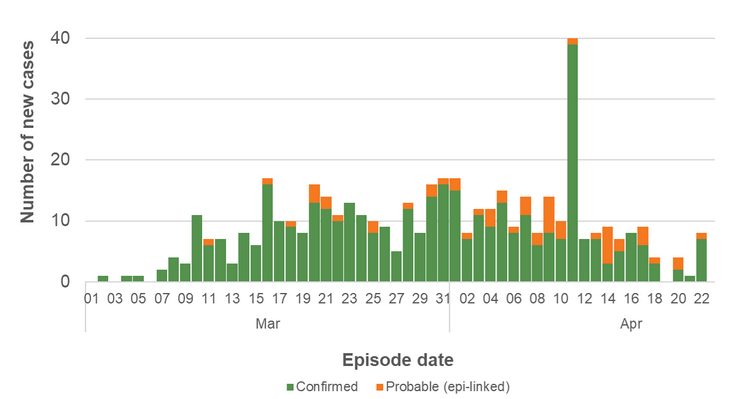
Figure 1: COVID-19 cases, by episode date, Halton Region, Mar. 1-Apr. 22, 2020
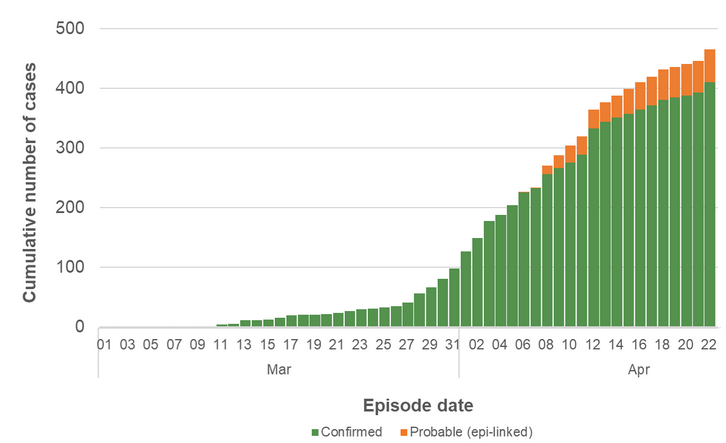
Cumulative COVID-19 cases, by episode date, Halton Region, Mar. 1-Apr. 22, 2020
Figures 1 and 2 show the 466 COVID-19 cases among Halton residents reported by end of the day on April 22. Unlike past reports, all cases have now been graphed according to their episode date, which is used to estimate the date that symptoms began. Figure 1 shows the number of new cases per day, while Figure 2 shows how cases have accumulated over time. Counts for the past 14 days should be interpreted with caution, since there is a delay between when a person becomes infected and when they develop symptoms, get tested, and are reported as a case. Please note the large increase on April 11 is due to expanded testing and identification of COVID-19 among asymptomatic individuals at Mountainview Residence.
Individuals who are lab-confirmed cases are shown in green. Individuals who are probable cases are shown in orange. Probable cases are epi-linked cases, which means they are presumed to have COVID-19 because they are symptomatic close contacts of cases or returning travelers who have COVID-19 symptoms.
Case demographics
70 cases were residents or patients of an institution experiencing an outbreak (15% of all cases)
64 cases work in health care (14% of all cases)
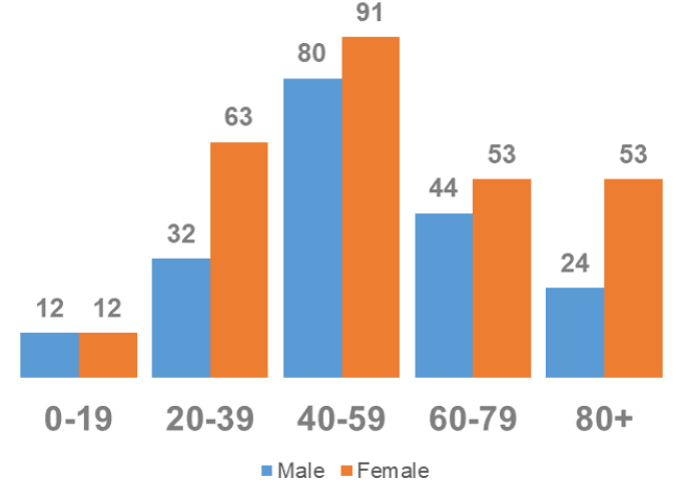
Figure 3: COVID-19 cases, by age and sex, Halton Region, 2020
Figure 3 shows that by end of the day on April 22, the most COVID-19 cases were among Halton residents aged 40-59 (with 171 cases, or 37%). 272 cases (59%) were female. Please note this figure excludes two cases with sex information pending.
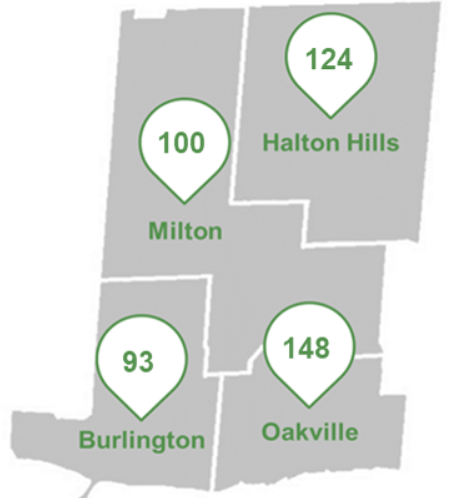
Figure 4: COVID-19 cases, by municipality of residence, Halton Region, 2020
Figure 4 shows that by end of the day on April 22, the greatest number of COVID-19 cases were among residents of Oakville (with 148 cases, or 32%). Please note this figure shows counts, and therefore does not take into account the different population sizes or age structures of the four municipalities. Counts in municipalities can also be inflated by outbreaks that have occurred within institutions in their boundaries. The figure excludes one case with municipality information pending.
Case exposure source
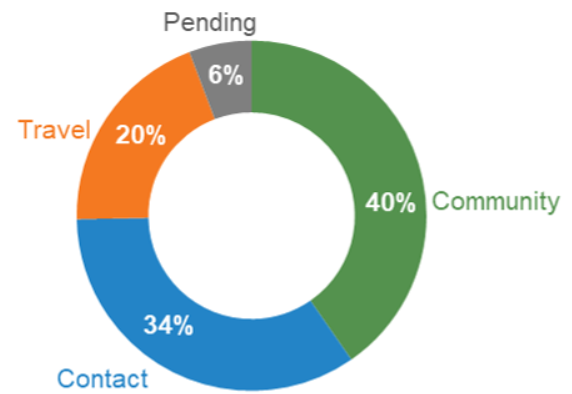
Figure 5: Percentage of COVID-19 cases, by exposure source, Halton Region, 2020
Figure 5 shows that by end of the day on April 22, 188 of Halton Region’s COVID-19 cases (40%) had no known travel or contact history, and therefore were believed to have acquired the virus within Ontario, making them community cases. 160 cases (34%) had contact with a confirmed case that was believed to be the source of their infection. 91 cases (20%) had a history of travel that was believed to have been the source of their infection. Information on exposure source was pending for the remaining 27 cases (6%).
Case outcomes
60 cases who have ever been hospitalized to date (29 listed as currently in hospital)
217 cases who have recovered to date
18 cases who have died to date (9 of the deceased were residents or patients of an institution experiencing an outbreak)
Institutional outbreaks
9 confirmed institutional outbreaks of COVID-19 are currently ongoing in Halton
12 confirmed institutional outbreaks of COVID-19 reported to Halton Region Public Health to date
Among the 12 confirmed institutional outbreaks reported to date, six (50%) have been in retirement homes, four (33%) have been in long-term care homes, and one each have been in a hospital and a group home. Nine of the outbreaks remain ongoing. Please note these counts do not include any suspected outbreaks that remain under investigation.
Lab testing
>6,000 Halton residents are known to have been tested for COVID-19 to date
Comparison to Ontario
12,879 total confirmed COVID-19 cases reported in Ontario to date
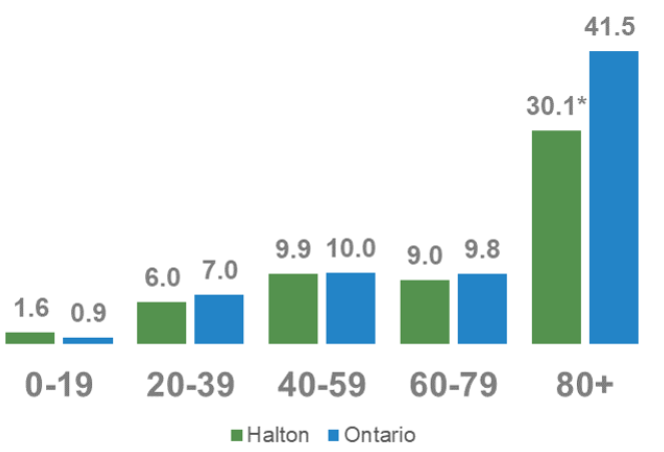
Figure 6: Age-specific rates of COVID-19 (per 10,000 population), Halton Region and Ontario, 2020
Figure 6 shows age-specific rates of COVID-19 for Halton and Ontario. Rates take into account the population size of each age group to make it possible to compare between different areas. Halton’s age-specific rates are currently similar to the provincial rates for all age groups except for residents aged 80+.
Halton has 30.1 cases per 10,000 residents aged 80+, which is statistically significantly lower than the 41.5 cases per 10,000 residents aged 80+ in Ontario overall. It is important to note that these rates will fluctuate as numbers increase throughout the pandemic, and that differences between age groups may reflect differences in the likelihood of developing symptoms and being tested.
Data limitations and data sources:
Halton case data: integrated Public Health Information System (iPHIS), extracted at 7:00 AM on April 23, 2020, to reflect data entered by the end of the day on April 22, 2020
Halton lab data: COVID Data Information System, extracted on April 20, 2020.
Ontario case data: Public Health Ontario, Epidemiologic Summary, COVID-19 in Ontario: January 15, 2020 to April 22, 2020, posted on April 23, 2020 to https://www.ontario.ca/page/2019-novel-coronavirus
Denominators for Halton and Ontario age-specific rates: Population projections [2020], IntelliHEALTH Ontario, extracted on April 8, 2020.
Data notes
All cases of diseases of public health significance diagnosed in Ontario are entered into iPHIS by local public health units. iPHIS is the Integrated Public Health Information System. It is a dynamic disease reporting system which allows ongoing updates to data previously entered. As a result, data extracted from iPHIS represent a snapshot at the time of extraction and may differ from previous or subsequent reports as data are updated.
The data only represent cases reported to public health and recorded in iPHIS. As a result, all counts will be subject to varying degrees of underreporting due to a variety of factors, such as disease awareness and medical care seeking behaviours, which may depend on severity of illness, clinical practice, changes in laboratory testing, and reporting behaviours.
Cases are included if their “diagnosing health unit” in iPHIS is Halton Region, which means counts include only individuals whose primary residence is in Halton Region. The case may not necessarily have been managed by Halton Region, if they were temporarily residing elsewhere during their case management period. Cases managed by Halton Region who normally live elsewhere but who were managed by Halton Region staff because they were temporarily residing in Halton during their case management period have not been included.
Cases for which the Disposition Status in iPHIS was reported as ENTERED IN ERROR, DOES NOT MEET DEFINITION, DUPLICATE-DO NOT USE, or any variation on these values have been excluded.
Figure 1 distinguishes between lab-confirmed and probable cases. Since April 7, probable cases are defined as epi-linked cases, meaning they are symptomatic close contacts of cases or returning travelers who have COVID-19 symptoms and therefore are presumed to have COVID-19. All other figures and numbers include both confirmed and probable cases combined.
Figures 1 and 2 use episode date, which is a field that is intended to approximate the symptom onset date for each case. It is calculated hierarchically, using symptom onset date if available; when it is not available, specimen collection date is used; if neither symptom onset nor specimen collection date are available, the lab test date is used; and finally, if none of these other dates are available, the date the case was reported to Public Health is used.
In subsequent reports, counts in Figures 1 and 2 may increase as cases are added from past dates as individuals become symptomatic, get tested, and their results are reported to Halton Region Public Health, as well as any past results are added due to delayed data entry or new arrival of lab results.
Cases are considered to be patients or residents of an institution experiencing an outbreak if they are linked to a confirmed Halton institutional outbreak in iPHIS, and they are not known to be a staff person at the institution.
Cases are considered to work in health care if they are known to have an occupation that involves caring for patients, e.g. physician, nurse, occupational therapist, recreational therapist, chiropractor, paramedic, midwife, orderly, etc. Individuals who work in health care settings but do not provide direct care to patients (e.g. managers, cleaning staff) have not been included.
Exposure type is determined by examining the exposure and risk factor fields from iPHIS to determine whether a case travelled, was a contact of a case or neither. A hierarchy has been applied as follows: Travel-related > Close contact of a confirmed case > Neither (indicating community acquisition) > Information pending.
Case outcomes (hospitalizations, recovery, deaths) reflect the latest available information reported to Halton Region Public Health and recorded in iPHIS by the extraction time.
Institutional outbreaks include outbreaks of COVID-19 in settings such as long-term care homes, retirement homes, hospitals, and prisons.
Lab testing data reflects only lab tests that have been reported to Halton Region Public Health and entered into CDIS. There may be more residents who have been tested but not reported to Public Health.
For daily Halton case tables and up-to-date information about how to protect yourself and others, please visit halton.ca/covid19
For daily provincial epidemiologic summaries and more information on COVID-19 in Ontario, please visit Ontario.ca/coronavirus
For national information on COVID-19 in Canada, please visit Canada.ca/coronavirus

















